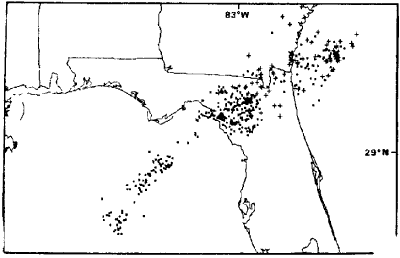 |
Science Frontiers ONLINE No. 57: May-Jun 1988 |
|
|
The large-scale structure of electrical storms
Ground-based observers see only a few of the anvil-shaped clouds comprising a big electrical storm. The entire storm may stretch for hundreds of kilometers -- and it is not a simple structure.
The latest surprise is that all large electrical storms are bipolar; that is, the rare positive lightning strokes are concentrated at the northeast end of the storm complex, while the negative strokes are everywhere else along a northeast-southwest line. This bipolar structure persists for several hours, and it has been found in all North American storms analyzed so far. This insight into the structure of large electrical storms was provided by magnetic lightning detectors that have now been installed over nearly 75% of the United States.
The positive lightning strokes are of longer duration and more liable to start fires than the common negative strokes. But why are they concentrated at one end of the storm complex? R. Orville ventures that in a big mesoscale electrical storm, the prevailing winds blow the positively charged upper portions of the clouds to the northeast, thus establishing bipolarity.
(Orville, Richard E., et al; "Bipole Patterns Revealed by Lightning Locations in Mesoscale Storm Systems," Geophysical Research Letters, 15:129, 1988. Also: Anonymous; "New Lightning Theory Strikes," Eos, 69:57, 1988.)
Reference. Large thunderstorm complexes are cataloged in GWH3 in: Tornados, Dark Days. For ordering information: visit: here.
 | Lightning distribution across Florida on February 22, 1987, 8:00-9:00pm. The plus signs designate positive lightning strokes. |